Before we start on orchid pathogens, keep in mind that orchids are sensitive plants. If an orchid is well taken care of, it will be strong and thus have high resistance against pathogens. Regular routine of feeding, watering and chemical application on the plant will help keep pathogens away. So take good care of your orchids and in turn they will flower well for you.
Most of the time, one disease can lead to another in a cascading effect if the primary issue/disease is not taken care of. Growing orchid takes a lot of care, observation and dedication.
Bacteria / Fungal Ailments
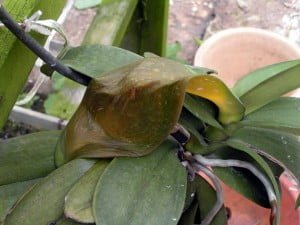
Brown Spot
Brown spots can be caused by mechanical injury to the plant, over-watering and mechanical pest attacks. The ruptured epidermal layer of the orchid leaves provide wet substrate for opportunistic pathogens to colonize.
To remedy, first apply fungicide to the brown spot to prevent fungal growth. If the fungal/bacteria growth continues spreading, cut off the infected portion of the plant. Dip the cut portion in fungicide, dry it before transplanting it.
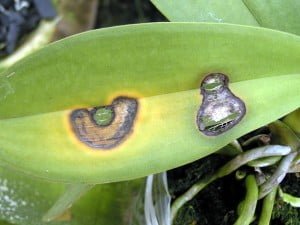
Black/Ash Spot
Black spots are usually due to chemical burns. When mixing your fertilizers, fungicide or pesticide. Ensure that mixing is done well in a container before applying them to the plants. Uneven mixing can result in crystals burns during hot afternoons resulting in small black spots on the leaves.
Black spots may also happen due to too much sunlight. Orchids are picky plants, always remember to provide yours with the right amount of sunlight for the type of orchid that you are growing. If an orchid leave starts turning yellow, this might be due to too much sunlight, provide the plant with some shade and the leaves should turn back to green. Prolong period will end up in burnt spots. Burnt spots can result in further chemical burns as the innards of the plants are exposed on the edge of the burns when treated with chemicals. If fresh burnt spots are kept wet due to rain and watering for prolong periods, secondary bacteria infection can set in.
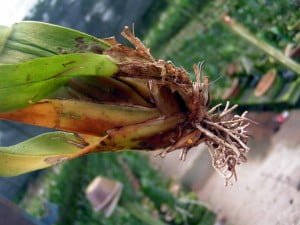
Root Rot
Root rot occurs due to incompatible basal media or over-watering. This usually happens for epiphytic orchids (e.g. Dendrobiums) as they grow naturally on trees and thus their roots should never be waterlogged.
Root rot also attracts opportunistic microbes and subsequently snails and slugs as the wet substrate provides a good meal for them.
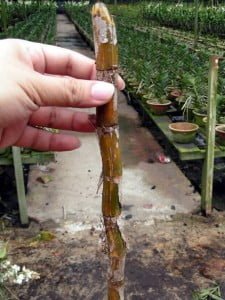
Stem Rot
Stem rot usually occurs from bottom up from root to stem to leaves. This happens when root rot is not remedied and occurrence increases with secondary pests such as snails and slugs sucking sap out of the soft fleshy tissues colonized by bacteria/fungi.
Secondary fungal/bacterial infection by a different type of pathogen may also occur after the initial colonization. This is common for badly neglected orchids.
Crown Rot
Crown rot usually occurs from waterlogged crown. When watering orchids particularly Vandaceous types, always take note not to allow water retention in the crown. This is also why we frequently advice our customers to water their plants during the morning rather than in the evening as water in crown will dry up in the afternoons.
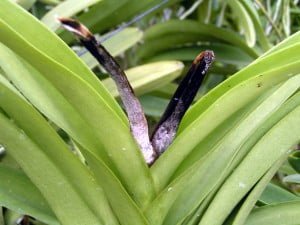
Vandas with crown rot will stop growing vertically as the apical meristem has been damaged. It is advisable to perform a top cut below the rot to produce keikis from the axillary buds if you wish to salvage the plant.
Mechanical Injury
Movements in your garden due to children, pets or even yourself can caused damage to orchid leaves unknowingly particularly for terrestrial orchids (e.g. Vanda). The exposed areas from the broken leaves will be susceptible to bacteria/fungal infection.

Mold/Soot
Mold or sooty black fungi may grow along basal axillary joints between the stem and leaves of Vandaceous orchids, commonly due to accumulation of water in these axillary joints. This is usually not serious if the epidermal layer is not damaged. The mold/soot can be easily wiped off with a cloth dabbed with very diluted detergent to clean up the leaves. However, if left for prolong periods, this may result in epidermal necrolysis and develop into similar condition as described for crown rot.
Other factors
If you have other plants grown within your garden, e.g. this banana tree, you may have more problems with pests like snails and slugs.
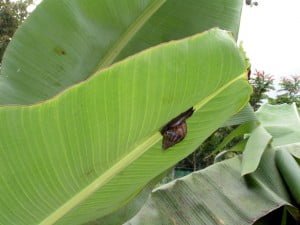
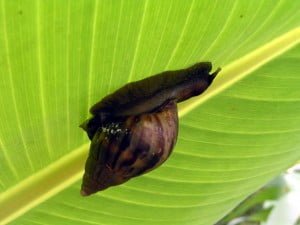
Basic remedy for damaged plant parts
- Cut off the infected portion of the leaves, stems, roots or pseudobulb and discard them.
- Wash any remaining dirt off and dip the plant into fungicide (e.g. Thiram).
- Leave the plant out to dry off the fungicide before transplanting the plant.
- Observe. If root rot occurs again, you probably didn’t remove the infected portion of the roots or treat the plant properly.
- Repeat process if required.
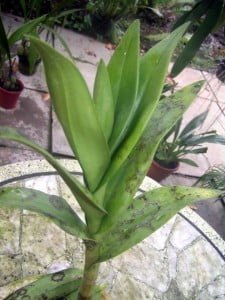
Viral Ailments
The main virus that affects orchid are Cymbidium Mosaic Virus, Cymbidium Necrotic Ringspot Virus, Tobacco Mosaic Virus and Odontoglossum Ringspot Virus. Infection can be very common in Dendrobium and Oncidium orchids in the tropics. This virus is transmitted from cell to cell through their plasmadesmata and impedes the orchid from growing properly. The virus forms a distinct circular pattern on the orchid leaves.
When the virus spreads dominantly across the leaves, they will start to yellow and die off together with the virus.
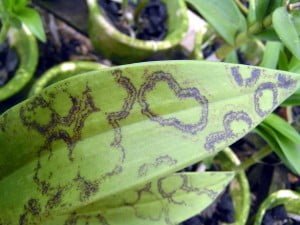
This infection is usually a considerably slow process as compared to bacterial/fungal infection, especially if the plant is well taken care of.
It is not possible to completely rid the orchid plant of viruses; however the infection can be gradually contained in young plants. Notice in the first picture that this virus is more prevalent on the older leaves. This virus replicates itself in the cells of the orchid leaves and gradually gets transmitted to newer leaves.
To contain the virus in a young plant, simply strip off all infected leaves by pulling them downwards or making a clean cut at the base of the leaves. Dip the plant in fungicide to prevent any fungal growth and allow the plant.
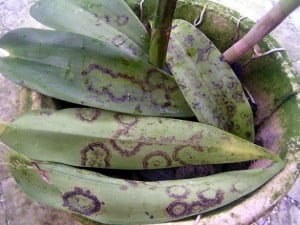
New leaves produced will be more resistant to the virus. Continue removing any infected leaves overtime as the plant grows and the prevalence of the virus will gradually decrease. This can be a long process but if done correctly, the viral infection will be kept low gradually.
The virus will lay dormant in strong plants and may surface again as the plant senesce. Plant resistance, similar to human, grows weaker over time as it accumulates damages, diseases and infection throughout its growth. However, do not fret when your orchid gets old. You can always produce keikis or produce seedpods from them to have new orchid plants for growing again.
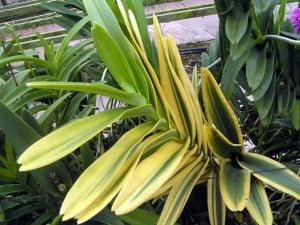
Genetics Ailments
As the name suggests, genetic ailments can never be corrected. Not all genetic mutations are bad, those that results in the plant having slower growth, lousy flowers and disease prone are bad. Sometimes in genetic mutations can produce beautiful effects like Dendrobium Liberty Mutation, splashes on the petals and petal fusion that results in rare prized collectible orchids.
Common Insect Pests
Insect pests that affect orchids include spider mites, thrips, slugs, snails and midgets. These are large pest, that can be easily observed and removed by applying insecticides.
Spider mites, also commonly known as red spiders, hide on the underside of orchid leaves and suck sap out of its host. Severe pest infection can result in dwarf plants, reduced in flowering and small and deformed flowers due to their feeding on the plant’s sap. This pest spreads fast and can be persistent.
Thrips and midgets are common pest for Dendrobium orchids. These insects use the buds of orchids, particularly Dendrobium to house their eggs. When their young hatch, they feed on the sap of the plant from within the buds, resulting in the buds falling off prematurely or having poorly formed flowers. Thrips/midgets can be killed and warded off using pesticides such as Imidacloprid.
Slugs and snails feed on wet substrates of the plant. Aside from being secondary pest after primary plant infection by microbes, snails/slugs are also common after a heavy rainfall. The Oncidium and its alliance are particularly vulnerable to snails/slugs after rain due to their soft petals. After heavy rain, often the soft lips of the Oncidium flowers will go missing where snail/slugs are rampant. Snails/slugs can be remedied by throwing snail/slug pellets (molluscicide) around the vicinity of your orchid. These molluscs will dissolve into liquid with a uric smell upon consuming these pellets.
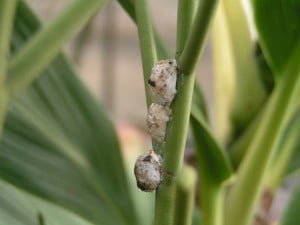
Caterpillars can also appear on poorly maintained orchids. Caterpillar attacks the flowers and soft chewy parts of the plant, e.g. the crown or spiny tip of a Vanda teres. This can end up with parts of the leaves dying and drying up as the sap were sucked out by the caterpillar or flowers damaged. Caterpillar eggs are usually laid on the underside of the leaves as it provides shelter for them, and also making them not easily visible. Where infestation is low, caterpillars can be removed manually using a pick or pointy petiole of a leaf to transfer instead of killing them with pesticide. Personally I don’t think caterpillars are that bad for private garden as they will moult and change into a beautiful butterfly later on. =P
Precautions for Treatment
- After using an orchid shear to cut off infected portion, remember to sterilize it by flaming the blades with a lighter, dipping in fungicide solution etc before cutting the next piece to reduce transmission.
- When cutting off infected portions, always cut an extra bit more of the healthy plant so as to ensure that the remaining portion will never be incontact with the infected portion.
- Be careful not to damage other plant parts with the sharp edge of the scissors, open wounds are susceptible to infection by microbes. Expose areas should always be minimize and treated with fungicide where required.
- Never use old media for transplanting as it’s likely to be contaminated.

Hi,
May I know how to get rid of spider mite?
Thanks,
Nwe
Hello Nwe,
You can get rid of spider mites by spraying miticide on the orchid leaves. Most spider mites will reside on the bottom side of the orchid leaves, thus if your orchid is infected with spider mites, always remember to spray your miticide on the underside of the leaves.
Cheers
silverelf
Could you recommend a miticide that you sell? Does Malthion
kill Red Spider Mites?
Does Malathion 84.3% kill spider mites? How about Dimethoate or
Diazinon? Which do you sell and what’s the price. I read that
Kelthane is very effective but was banned from usage in Singapore.
Is it true?
Dear Mr Teo,
The miticide that we use are in commercial packs for farm use.
At the moment, we do not sell miticide or other chemicals but will look into this as, like you, many customers has requested for them.
Yes Malathion eliminates red spider mites. For a non toxic alternatives, you can use summer oil instead. Its ecologically friendly and has minimal toxicity to human. You should be able to get these in horticulture section of supermarkets like NTUC and cold storage.
silverelf
Hi Mr Teo,
Apologies for the belated reply.
Yes the chemicals that you’ve mentioned are all pesticides.
Kelthane is probably banned as DDT is one of the intermediates used in its production.
DDT is banned due to several reasons, you can read more on wiki here: http://en.wikipedia.org/wiki/DDT
We do not sell chemicals at the moment but they can be easily purchase from supermarkets near your home.
silverelf
I spray fungicide after every rainfall, even if it meant everyday.
Is this correct because I feel that once the residue on the leaves
has been washed away by rain the plant is exposed to pathogenic
attack.
I spray fungicide after every rainfall even if it meant everyday. I
feel that once the residual powder is washed away, the orchid plant is
unprotected against fungal attack. Is this reason to spray the chemical
correct?
Hi Mr Teo,
Yes that is the correct method. You can also add neem oil/white oil to your fungicide as it helps to adhere to the plant surface.
silverelf
My orchids are always exposed to the elements. I don’t have
a place to prevent rain from destroying their roots.
So, what should I do to compensate for the root destruction?
How does one go about saving them if rainfall is too frequent?
Thanks!
Hi Silverelf, firstly like to thank you for such informative site for orchid lovers! Most relevant to me since I m from Singapore too.
Need advice abt my Vanda. I got one abt 3 weeks ago and everything seems fine with all buds flowering. Suddenly 1 leaf (7th from the crown) turn splotchy and yellowing almost overnight, much like an over ripen banana. All other leaves are fine. I had snipped it off in case it spread. That leaf was still firm to touch. I have fertilised the plant twice so far with 63 sprayed lightly on whole plant.
If there is a way I could attach a picture…
Hi Wong,
Its okay to snip off the leaves.
Its probably due to mechanical damage.
The leaves may have been accidentally folded or damaged resulting it to turn yellow. The plant will still grow but aesthetically, it may not be as nice looking as with full leaves.
You may also do a top cut the orchid above the damaged leaves if there are roots and replant the orchid so that it can grow new leaves but this is not required.
silverelf
Hello silverelf:
How could i control these kinds of snail are eating the rooting system of my dendrobium. Their very voracious feeders. Can please recommend any chemical application. Im leo from the southern part of Philippines. Can anybody out there dare to give comments and advices.
Hello Leo,
You may control them by applying snail pellets around the perimeter of your orchids.
The snails and slugs will go for these pellets instead of your orchids. =)
Apply this over a period of 3 months and you should be able to get rid of most of your slugs and snails.
You will need to get small pellets for small snails and big pellets for larger ones to be more effective.
silverelf
Hi silverelf, may I know how to treat black rot on cattleya’s new lead? Should I cut it off? Thank you, Isaac..
Dear Isaac, you can use fungicide to treat them or if serious cut it off. There in a page in our website for Orchid care, http://tohgarden.com/orchid-care/common-orchid-pathogens/
How often should I use fungicide or pesticide on orchids?
How do I apply them?
Appreciate your advice. Thank you.
Hi Tracy,
Once to twice a week will be sufficient.
silverelf
Hi silverelf, I just discovered that under the leaves of one my outdoor hanging dendrobium are many silverish-white regions, although I don’t see any insects per se, nor any webs. There are small, black “sediments” on the underside though, but non-moving. Then I notice there are similar white regions, but much smaller, on the underside of other dendrobiums nearby too. If I could post some photos it might be clearer.
Do you have any idea what the problem is and how to treat it? Thank you!
Hi Lynn,
The white silverish region you observed may be fungicide residues that adhere to the leaves, those are not insect webs. We use fungicide with summer oil to adhere them to the leaves of the orchids. This protects the orchid plant from fungal growth. You may send pictures to [email protected].
silverelf
Hi silverfish, my orchid collection has been ruined by crown rot. How could such rot be controlled when our orchids are left in the
open exposed to rain. Could spraying fungicide stop the nuisance?
Hi silverfish, I have thrips problem in my small orchid nursery. I spray insecticide (decis n malathion), once every 2 weeks and I rotate them. But somehow only some of the thrips die and many still survive and multiply very fast. Do you know whats the best way to control this infestation?
Hi Eric,
Increase the frequency of the insecticide spray to twice a week.
That should solve the problem.
silverelf
Hi Silverelf, what fungicide and pesticide (systemic) would you recommend?
Hi Juli,
We use Thiram and Imidacloprid.
There are quite a number of options for fungicide and pesticide available locally.
silverelf
Hi Silverelf,would you recommend a cure for Fusarium,i’ve lost 3 vandas to it.It started with the base of the leaves turning brown while roots were still white, firm and fine,then stem started to turn brown and even the green leaves starts to shiver. I tried to save it by cutting upwards where the stem still green but it did not work at all.Thank you.
Hi Ms Ong,
Try applying some fungicide to treat the Fusarium first.
Apply the fungicide and let the plant dry out so that it kills the fungus.
silverelf
Hi Silverelf,
Will Captan (Horti) works? i read online to use ‘Daconil or Cleary’s 3336’ but i cant seems to find any of these in S’pore.I’ve even tried cinnamon oil and need oil but is not working and is spreading fast to my other orchids
Hi Silverelf,
Will Captan (Horti) works in treating Fusarium as i cant find any Thiomyl WP 50% in S’pore, recommended from the internet. I’ve even tried cinnamon oil and neem oil, none is working.
Hi Ms Ong,
Captan is a pesticide not a fungicide.
Try using a fungicide instead to cure the fusarium fungi.
Allow the plant to dry out after application.
silverelf
Hi silverelf, part of my orchid plants leaves suddenly turned white. Some leaves turned white in between leaving both ends still green. Some about 3/4 of the leaves from the tip. Can the cause be of spraying of insecticides?
ckh
Hi ckh,
Yes, it’s possible due to concentrated chemical burns.
Make sure that you’ve diluted the chemical as specified on the bottle.
silverelf
hi silverelf, i have a Vanda, and its leaves in the middle section have black spots, then dry off and fall out. The stem also turned woody.
The roots and crown of the Vanda still look healthy, and it is still growing. Never bloomed though, and it gets morning sun.
What could be the cause of the leaf fall and woody stem?
I was wondering if anyone has encountered this before and if they have any advice. I just noticed that one of my phalaenopsis orchid plants had a huge leave that slowly turned into mush. I touched the leaf and it was rotted and all around was it’s moisture. I don’t know how to describe it properly. It was turning into a jelly mush. The rest of the plant is healthy and it has a tone of blooms. I cute off as much of what was left as close to the beginning of the plant. It’s weird no other leaves have done this. I have literally had hundreds of orchids and never saw the plant biodegrade like this. Any thoughts?
Hi Nicole,
This can occur due to over watering.
Make sure that your orchid media has dried off completely before you water them again.
Constant wet media can cause root rot which can kill the plant eventually if left untreated.
silverelf
Hi there, what is the best method to grow novelty phalaenopsis type of orchid in our climate? As I have stumbled with mold appears after repot in semi-hydro method also bark & moss method. It’s place at my covered balcony with right light amount positioned and pretty good natural aeration. Water them when it’s dries. I also spray a right amount hydrogen peroxide during repotting process on the roots. It’s seem mold keep and keep appear on the roots, I can’t find a better growing method and solution. As for media, it’s fresh and sanitised as advice. Is it because of the media it’s self or because I mix it. Please help on this, I begin to getting little bit frustrated with this mold. Lemme know what are the growing method you use making it grow thriving
Hello Jimmy,
Try using fern bark to grow them and you can apply fungicide once a week to keep the mold at bay.
silverelf
Bought a Vanda 2 months ago with buds. The buds didn’t bloom fully, and dropped off after a week. Now the leaves are starting to get large round black/brown spots with a yellow halo around them. I cut these off. The roots look okay, but scrawny. Orchid is hung indoors near window facing north-west. Watered/ sprayed the roots every 2 days. Fertilised with leaf fertiliser twice a week, soaking the roots for 10 mins each time. Fertilised with flower fertiliser twice a month, same method.
Any way to revive this plant?
Hello Phyllis,
The yellow halo is likely a sign of fungal infection on the leaves.
When you cut off the leaves, its best to apply fungicide on the open wound to prevent fungal infection.
Its fine, Vanda will continue growing new leaves from the top and more flowers will bloom from the new growth.
silverelf
Hello Silverelf! My vanda seems to have been pollinated but the plant does not look too healthy (some dried roots here and there) should I let it develop into a pod or cut the flower stem off to help the plant conserve energy? Also, if there are a lot of dried roots stuck in the basket, is it safe to cut the basket and transfer the plant to a tree stump? It doesn’t seem like the best action but am wondering if fungus or mold will grow in it if not transferred :/
Hi Nic,
You can remove the other flowers on the stalk to help to seedpod grow.
Its better not to transfer until the seedpod is fully formed.
silverelf